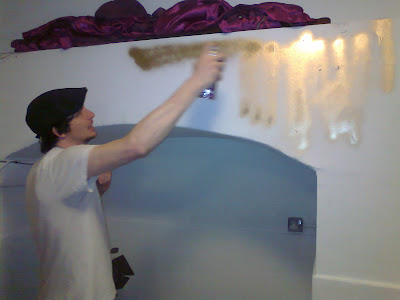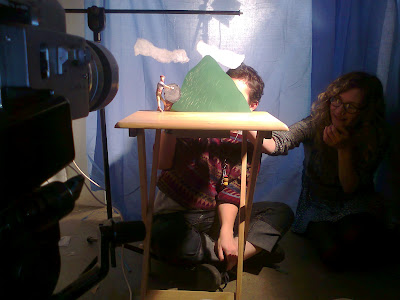Breaking Out and Breaking In is a distributed film festival co-ordinated by the ever-inspiring
BLDGBLOG. Taking as its theme "the use and misuse of space in prison escapes and bank heists, where
architecture is the obstacle between you and what you’re looking for", the festival encourages geographically dispersed cinephiles to watch a series of set film texts and respond online (there will also be a bit of a do in New York when it’s all over).
On Friday 24th March, we participated with a screening of Vincenzo Natali’s
Cube (1997) at
Old McHale’s Mantelpiece Cinema, the Institute’s pocket picturehouse in south Manchester. The McHale’s way of doing things involves various rituals and etiquettes, such as the preference for a double bill (to draw out unexpected connections between tentatively linked films), a thematic cheeseboard (with contributions from proprietors and audience alike) and projection onto the textured wallpaper of the McHale’s chimney breast. Although discussion is encouraged at McHale’s, the Breaking In/Out event marked the first time we’ve set aside specific slots for group speculation. These breaks doubled as convenient moments to revisit the cheeseboard.
As co-proprietor of the cinema, I shall herein attempt to summarize our architecturally-oriented findings. Spoilers will abound.
Clumsy heroics
Following a last-minute revision of the evening’s program, we open with two escape-themed episodes of
The New Adventures of Tarzan (1935) –
Crossed Trail and
Devil’s Noose. The opening escape from a temple where our hero is about to be executed/sacrificed is more about low-scale genocide than the exploitation of architectural ambiguities:
But this particular incarnation of the E.R. Burroughs adventure is more fascinating for its semi-developed, yet semi-decayed, cinematic grammar than its reflections on real-world spaces. Shaped by the naivety of its early talkie form and eroded by years of material neglect, the show seems to be put together from a mix of surviving prints. The result is a curiously compressed space-time of the jungle, where people are closer than you think and emotions can be rebooted with a cutaway:
The taming of our environment through technology and architecture has both intended and unintended results, malicious and accidental. Thus it is a series of accidents (and a neat symmetry of the elements) that results in Tarzan being suspended in the air by an animal trap (the Devil’s Noose) even as he tries to rescue love interest Ulla Vale from the firy prison of a flaming cabin.
Theory of remains
Next on the bill is
Jean Rollin’s short
Le Pays Loin (
The Far Country, 1965). A young man meets a young woman in a nameless town and they search for a way out, through a maze of ruins and micro-enclaves. It is the dérive as nightmare, the cosmopolis as isolation cell. Nobody they meet speaks their language, and the exotic (urban) cultures they encounter remain insular, however harmless. They meet another couple who are, on reflection, probably in the same situation as our heroes, but who of course don’t speak French: the mutual frustration leads to violence. You aren’t trapped by society, as
Cube will later reinforce: you
are society.
If Rollin ultimately settles on truisms (love is the answer; we’re all of the same flesh),
Le Pays Loin remains of interest for its contemporaneous alternative to the
Situationists’ take on urban planning and cultural homogenization. Rollin’s prison-city is not the modernist rat maze the Situationists would critique and subvert: it is closer to the organic, irrational playground they idealized. Again, this dichotomy will be echoed in
Cube: is civilisation a conspiracy or a series of accidents and inevitabilities?
 Le Loin Pays at McHale's
Le Loin Pays at McHale's
Cheese Cubed
We prepare for the main feature by topping up our glasses and plates. There are thematic cheese cubes and olives on sticks (the latter rationalised by the claim “the pimento wants to break out”), and
Breakaway bars for the sweet-toothed (which British delicacy proves a revelation to Colorado-reared guest – and sound designer on the Institute’s
UNIVERSAL EAR project –
Mr Cacioppo Belantara). There is wine.
Our initial response to Cube is to identify it as a massive game – a scaled up
Mousetrap,
pick-up sticks or, of course, Rubik’s cube (some recall there being a Mousetrap movie, but when do we get a Jerry Bruckheimer pick-up sticks blockbuster?). Just as the trials of life are scaled down in the toys and games with which we are socially trained, the apparatus and the stakes of these games are scaled up for our heroes, who must think, perform and behave with guile and agility to win survival. (It also recalls Natali’s
Cypher (2002), where in order to prevail, Jeremy Northam’s character must play dumb and fit in with a virtual community while privately plotting his own escape).
The social agenda of the cube revolves around the idea that we each have a function to perform if our home, village or metropolis is to thrive. Whether the evil mastermind behind the cube (or his/her casting director) chose prisoners with complementary skills as an over-zealous experiment, as a demonstration, or as a cynical joke, is never revealed: the prisoners include a policeman (to direct the human traffic), a mathematician (to crack the codes), and an autistic chap - Kazan - with the spark of genius the group, and society, needs to progress. (Ms Kipling, in the audience, suggests that the special skill of the short-lived bald guy, killed off early to demonstrate the cube’s lethal logic, is ‘exposition’). The acknowledged irony is that life outside the cube is just the same: Worth, who designed the outer walls of the cube, admits to never having met the "door guy" or anyone else involved in the construction. Yet the cube is complex, rational, and continues to function.

Cube: co-operation
What the cube lacks, and what makes our mutual dependency in real life a little more palatable, is horizons. (The cube also lacks toilet facilities, and although the prisoners turn their noses up when Kazan pees in a corner, the subject is not brought up again during their lengthy incarceration - where do the others go?). Each of the six inner-faces of every cell is identical, these cells’ frustrating, alien omni-directionality made more absurd by the repeated image of a boot flying forlornly through the air. Each boot is tossed ostensibly to trigger booby traps, but figuratively it is searching for gravity, a firm footing, orientation, an absolute.
The vaster space of the cube as a whole is hinted at throughout the movie by its peculiar
sonic life: distant, echoing creaks and moans which the characters seem to ignore and which therefore remain ambiguous to the audience – are these the sounds of the cube or are they non-diegetic, a
film score of tones to pull the audience along without the comforting familiarity of rhythm or melody? A third alternative is that the sounds are subjective: half an hour in, as Holloway loses her composure, the cube groans and creaks as though its very frame is straining to keep itself together. The big reveal to characters and audience alike is that the first idea is closest: the noises occur as a side-effect of the cube’s sporadic reshuffling of cells.
We turn to Mr Hill, McHale’s guest engineer (and also the inspiration for the Institute’s
2009 choreographic exploration of mental space) for a technical take on the cube. Hill postulates on the use of rails or runners on which the inner cubes would need to slide and points out that the magnetism involved in heaving such massive blocks of metal around would likely have physio- and psychological effects on the prisoners. For that matter, the lack of oxygen could account for Quentin’s descent into psychopathy – is there not something of the submarine movie in
Cube?
And so we wind up back at psychogeography, or more accurately psycho-ambience. If there was, indeed a ‘door guy’, the characters are so preoccupied with survival that they don’t have a moment to give the ‘wallpaper guy’ a nod. The inner panels of the cells are decorated in something between an art deco flourish and 1980s, Tron-esque circuit board chic. This could be Natali flagging up the need for everyday folk to build our online universe with tolerance and co-operation. But more pertinent to our characters are two particular aspects of the panel design: firstly, that the backlit walls give the impression of daylight offering hope as through a stained glass window; and secondly, the use of coloured light as a mood modifier. It would take an audience soberer than the present one to trace any consistent emotional program in the cube’s
colour scheme: the autistic Kazan cannot abide the red rooms, but any effect on the others remains subliminal and unremarked upon by the prisoners.
Foreground: cheese cubes, Background: circuit board wallpaper
The program winds to a close, the crowds disperse, and Mr Hill and I accompany Ms Cookson back to her Withington digs, spotting on the way this most portentous sign:

It is our hope that the maze is not snapped up by evil hands. In the meantime, our Breaking Out night is deemed a success and we look forward to a Breaking In night or two:
Rififi on March 19th, and perhaps
Inception, which concept is made more palatable by the idea of a thematic cheese within a cheese within a cheese within a cheese.




































